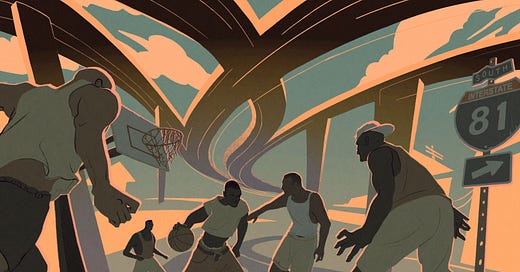Oh hey there!
Hello, my dear Signal Problems readers! How are you? I miss you all and your glorious Dog in a Bag submissions.
Even though Signal Problems is no more, I’m still following the goings-on at our beloved MTA. Not quite as closely as I used to, but I find that merely changing jobs has not changed the fact that I care about our mass transportation system.
So, I thought it might be fun to send you a quick update on some of the work I’ve been doing, share a few MTA-related thoughts, and see if you’ve spotted any Dogs in Bags recently. Maybe I’ll do this semi-regularly if it seems to go over well.
A Quick Update On Where to Find the S/P Dog in a Bag Collection
Reader Michael Pollack suggested I make the Dog in a Bag collection easier to find, which was a great idea. So you can now find the Signal Problems Dog in a Bag collection at my personal website, aaronwgordon.com, where you can also find my bio, clips, things of that nature.
On that site, there is now a dedicated tab for Dogs in Bags. But that is mostly a portal to the public Google Photos album I created. Hopefully, this will help you access those when you’re in need of some dogs in bags. If you have fresh ones, send them along, and I’ll add them to the album.
Tearing Down Urban Highways
As for the work I’ve been up to, a lot in my first few months has been getting up to speed with how the automotive industry works. I’ve found it both fascinating and, often, infuriating. But I’ve learned a lot that has deeply affected my thinking on the future of transportation in this country and where we go from here.
In general, I find urbanists and public transportation experts do not understand (or come to grips with) how the automotive industry works, how it affects policy at the local, state, and federal levels, and how it impacts individual behavior in profound ways. Until we start to reckon with that, it will be very difficult to implement change.
Along a similar vein, I thought some of you might be interested in a feature I just published about the role of urban highways in America. It’s an issue I’ve had my eye on since the BQE debate began anew earlier this year. But this article is not about the BQE, at least not directly. It’s about a 1.4-mile stretch of highway in Syracuse. Like the BQE, that stretch of elevated highway is at the end of its useful life. Something has to be done about. And it’s been at the center of a fight between the city and its suburbs for almost a decade, dredging up old wounds about racial discrimination, white flight, urban renewal, and the decline of American cities.
The second I heard about this story, I knew I had to write about it, because it’s about so much more than a transportation project. It’s about how we have to acknowledge the sins of the past in a more meaningful way in order to make progress on the issues affecting us today. I hope you’ll take the time to read it. I hear it’s all the talk around the presidential debate podiums.


MTA Gets Business Consultant’d
The big story around MTA parts recently—other than the fact that we were all lied to about the real reason why Joe Lhota resigned—has been the reorganization plan recently passed by the board.
Nobody seems to be a fan of it. Even some board members voted for it on the assumption that it can be changed later. Far be it for me to tell board members how to do their jobs, but that doesn’t seem to be what voting for something means. Either way, this is a pretty standard MTA board member cop out maneuver. If I had a nickel for every time I heard “I have problems with this, but I’m voting for it anyways” I wouldn’t have needed to seek full-time employment. Despite the plan’s unpopularity, only one board member, Veronica Vanterpool, voted against it.
So what actually is this plan? You can read the full plan here, which was put together by the consultant firm Alix Partners. Personally, I find the plan itself too vague to analyze with any degree of certainty. It’s only 36 business school jargon-laden pages heavy on charts and light on details, a pittance for a plan that will in theory transform a 70,000 person organization with almost $17 billion in annual expenses.
I don’t want to be too alarmist about this plan. It could turn out mostly harmless, it could also be a disaster, or be anywhere in between; it largely depends on how management implements the bullet points.
I do, however, feel confident in saying it doesn’t address the fundamental problems I have spent many a Signal Problems documenting.
But I do see one aspect of this plan broadly speaking that, to me, attests to why the MTA struggles to be productive as an organization year after year, generation after generation. The problem is that this is is a business plan for an organization that is fundamentally not a business.
The MTA was founded in the 1960s during an era where our leaders tended to believe all problems could be solved through dispassionate pragmatism. This was the Whiz Kid era, when this optimization model was applied by our best and brightest to everything from building cars, foreign wars, nuclear war game-planning, and fighting fires (not to spoil the plot, but it didn’t work out great).
The MTA was created in the midst of this dispassionate pragmatist craze by then-governor Nelson Rockefeller to achieve numerous goals—one of which was to neuter Robert Moses—but a key one was to bring this businesslike approach to public transportation. The idea was the MTA, like all government, should be run like a good business.
This is the lie on which the MTA is built: that public transportation can be a self-sustaining business if run well enough. But, as decades of experience here and around the world have proven, this is simply not true. With the exception of places like Hong Kong that are in essence real estate companies that happen to run trains, public transportation systems require large government subsidies to function well. (Even Hong Kong gets indirect subsidies by exemptions to all kinds of property and tax laws.)
New York has, in practice, done away with this fiction by subsidizing the MTA with billions of dollars every year. But it has never completely shed the lie. For one, the agency is legally obliged to balance its budget every year. This is paradoxically something no actual business has to do yet meshes with the idea of government that should be run “like a business” and not lose money. It is, of course, deeply ironic that many, many venture-capital funded businesses now give the MTA a run for its ability to bleed cash.
The MTA is hardly the only government agency hand-cuffed by similar ideological confusion; the Post Office and Amtrak are two that come to mind.
Nevertheless, the MTA meets this requirement every year in part through the aforementioned subsidies and also a large amount of budgetary rejiggering that occurs on an annual basis.
The point isn’t that the MTA should be able to run a deficit—although I’m here for that suuuuper nerdy conversation—but that the reorganization plan’s biggest flaw, to me, is it buys into this lie big time.
Alix Partners is a business consultant, not a public transportation consultant. In fact, they seem to have little to no expertise in public transportation. The “transportation and infrastructure” section of their website is almost entirely about global shipping. There is scant evidence they have done any serious work in the public transportation sector prior to this $4.1 million contract.
Nor did they spend very much time on this reorganization plan at all; 12 weeks or so. These quick turnarounds are part of the company’s sales pitch, which is all well and good when tearing apart for-profit business after for-profit business. The implication here is Alix Partners did little to adjust their approach or strategy or even acknowledge the MTA might be a fundamentally different beast than, say, Enron.
This is a super important point because the MTA’s structure, governance, function, and even purpose are codified into law and cannot be changed as a business’s can. That is why we are here, trying to fix the MTA. And assuming it can be run like a business is why we keep ending up back here, trying to fix the MTA, every few years.
To take just one of many examples, consider labor, the single biggest cost driver for the agency when including both salary and benefits. Negotiations between labor unions and MTA management do not work like those in the private sector, because the labor unions are also a key constituent (and donor) to MTA management’s boss, the governor. In other words, the unions can, and do, play both sides.
“The governor has been the best governor for the trade union movement ever,” TWU president John Samuelsen told the New York Times after attending a Cuomo fundraiser earlier this year. This was mere months before contract negotiations between TWU, which has more than 40,000 MTA employees, and the MTA began.
This is emphatically not how labor negotiations in the private sector work. I’ve been a part of one collective bargaining negotiation committee and now work at another union shop, which just concluded its own round of negotiations with management. Suffice it to say, negotiations would have gone very differently if we somehow had a back channel to management’s ultimate boss with non-trivial leverage over his professional future. And these negotiations determine not only salaries and benefits but work rules and all kinds of requirements that drive up costs.
But that is just one example; an important one, but just one. Everyday issues like service cuts, fare hikes, and implementing faster buses become instantly politicized in a way no business has to contend with. Bus network redesigns take years not because it takes years to figure out optimal routes but because it takes years to convince politicians and the people why their bus stops will change.
A business consultant might look at these delays as inefficiencies—indeed, it is “inefficient” from a time-spent metric—but it’s not inefficient when considering these changes can only be successful with careful community-based coalition building, something Alix Partners’s other clients hardly have to contend with.
So what is the MTA if not a quasi-business? It is, as I have argued before, a public good. The fundamental problem at the MTA’s core, generation after generation, is it is not allowed to function like one, always shrouded in the faux-principles of businesslike pragmatism. The Alix Partners reorganization plan makes this confusion worse, and, as such, reduces the chances any fundamental issues will be fixed.
Dog in a Bag
MTA Rules of Conduct Section 1050.9 Subsection (h) Paragraph 2: no person may bring any animal on or into any conveyance or facility unless enclosed in a container and carried in a manner which would not annoy other passengers.
Have a dog in a bag photo? Reading this on the subway and see a dog in a bag? Take a picture and send it to signalproblems@substack.com.

Photo credit: Jody Avirgan
If you want me to send out more of these occasional S/P’s that keep you in the know of my recent work and include some MTA thoughts, let me know.
Travel speedily,
Aaron


